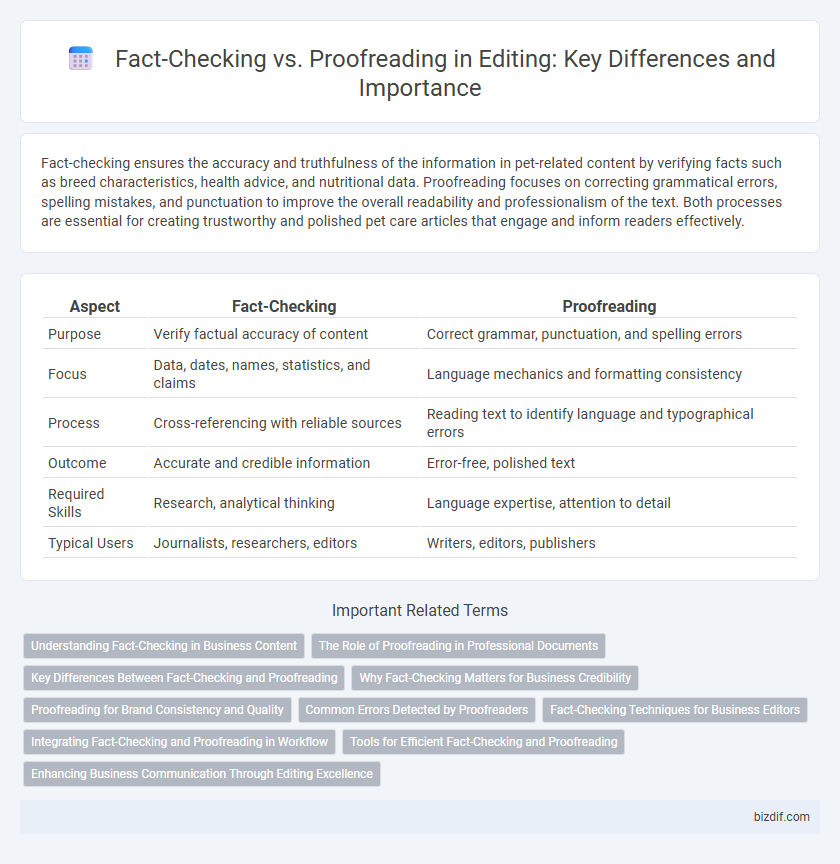Fact-checking ensures the accuracy and truthfulness of the information in pet-related content by verifying facts such as breed characteristics, health advice, and nutritional data. Proofreading focuses on correcting grammatical errors, spelling mistakes, and punctuation to improve the overall readability and professionalism of the text. Both processes are essential for creating trustworthy and polished pet care articles that engage and inform readers effectively.
Table of Comparison
| Aspect | Fact-Checking | Proofreading |
|---|---|---|
| Purpose | Verify factual accuracy of content | Correct grammar, punctuation, and spelling errors |
| Focus | Data, dates, names, statistics, and claims | Language mechanics and formatting consistency |
| Process | Cross-referencing with reliable sources | Reading text to identify language and typographical errors |
| Outcome | Accurate and credible information | Error-free, polished text |
| Required Skills | Research, analytical thinking | Language expertise, attention to detail |
| Typical Users | Journalists, researchers, editors | Writers, editors, publishers |
Understanding Fact-Checking in Business Content
Fact-checking in business content involves verifying data accuracy, sources, and claims to ensure reliability and build trust with stakeholders, investors, and customers. It requires cross-referencing financial reports, market statistics, and company statements to eliminate misinformation and prevent reputational damage. Effective fact-checking enhances the credibility of marketing materials, annual reports, and press releases, supporting informed decision-making and regulatory compliance.
The Role of Proofreading in Professional Documents
Proofreading ensures the accuracy and clarity of professional documents by identifying and correcting spelling, grammar, and punctuation errors that can undermine credibility. It enhances the overall readability and professionalism of reports, contracts, and presentations, contributing to effective communication. Fact-checking, while crucial for verifying information, complements proofreading by validating content accuracy rather than focusing on language mechanics.
Key Differences Between Fact-Checking and Proofreading
Fact-checking involves verifying the accuracy and validity of factual information, including dates, statistics, and names, to ensure content credibility and prevent misinformation. Proofreading focuses on identifying and correcting grammatical, punctuation, spelling, and typographical errors to improve the text's clarity and readability. While fact-checking targets content accuracy, proofreading targets language mechanics and formatting consistency.
Why Fact-Checking Matters for Business Credibility
Fact-checking ensures the accuracy and reliability of business information, safeguarding a company's reputation and fostering trust with customers. Unlike proofreading, which addresses grammar and formatting, fact-checking verifies data, statistics, and claims to prevent misinformation. This meticulous validation process strengthens brand credibility and supports informed decision-making across all business communications.
Proofreading for Brand Consistency and Quality
Proofreading plays a crucial role in maintaining brand consistency and quality by ensuring that all textual materials are free from spelling, grammar, and punctuation errors, which reinforces a professional image. This process verifies that language, tone, and style align precisely with the brand's guidelines, preserving the intended voice across all communication channels. Consistent proofreading helps prevent miscommunication and protects the brand's reputation by delivering polished, error-free content.
Common Errors Detected by Proofreaders
Proofreaders primarily detect common errors such as spelling mistakes, punctuation errors, and grammar inconsistencies that can affect readability and professional appearance. They also focus on typographical errors and formatting issues, ensuring uniformity in font style, size, and paragraph alignment. Unlike fact-checkers, proofreaders do not verify factual accuracy but concentrate on polishing the text for clarity and correctness.
Fact-Checking Techniques for Business Editors
Fact-checking techniques for business editors involve verifying financial data, cross-referencing company reports, and confirming claims with credible sources to ensure accuracy. Utilizing specialized databases and regulatory filings helps validate figures such as revenue, market share, and executive statements. This rigorous process reduces misinformation and strengthens the credibility of business publications.
Integrating Fact-Checking and Proofreading in Workflow
Integrating fact-checking and proofreading within the editing workflow enhances content accuracy and clarity by systematically verifying information while refining language mechanics. Employing specialized tools and checklists during the combined process ensures consistent verification of factual data alongside grammar, spelling, and punctuation corrections. This cohesive approach reduces errors and reinforces credibility, improving overall editorial quality and reader trust.
Tools for Efficient Fact-Checking and Proofreading
Fact-checking tools like Snopes, FactCheck.org, and Google Fact Check Explorer help verify information accuracy and source credibility efficiently. Proofreading tools such as Grammarly, Hemingway Editor, and ProWritingAid focus on correcting grammar, punctuation, and stylistic issues to ensure clear and polished writing. Integrating both types of tools streamlines the editing process, enhancing content integrity and readability simultaneously.
Enhancing Business Communication Through Editing Excellence
Fact-checking ensures the accuracy and credibility of business content by verifying data, sources, and claims, which builds trust and maintains professional integrity. Proofreading enhances clarity and professionalism by correcting grammar, punctuation, and syntax errors, ensuring polished and error-free communication. Integrating fact-checking and proofreading within the editing process elevates business communication quality, fostering clearer messaging and stronger stakeholder confidence.
Fact-checking vs Proofreading Infographic

 bizdif.com
bizdif.com